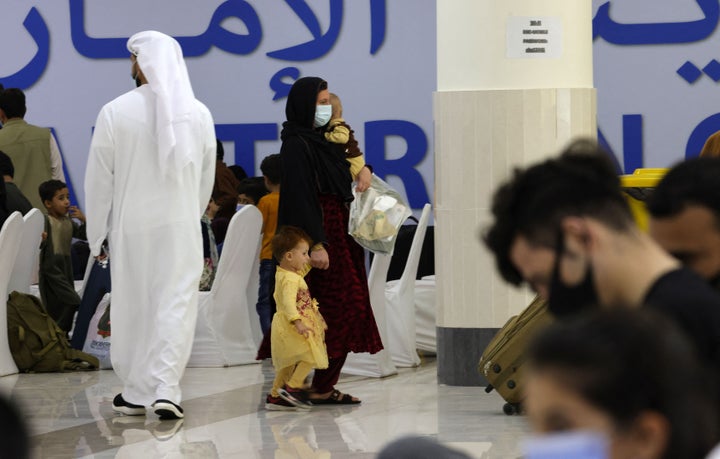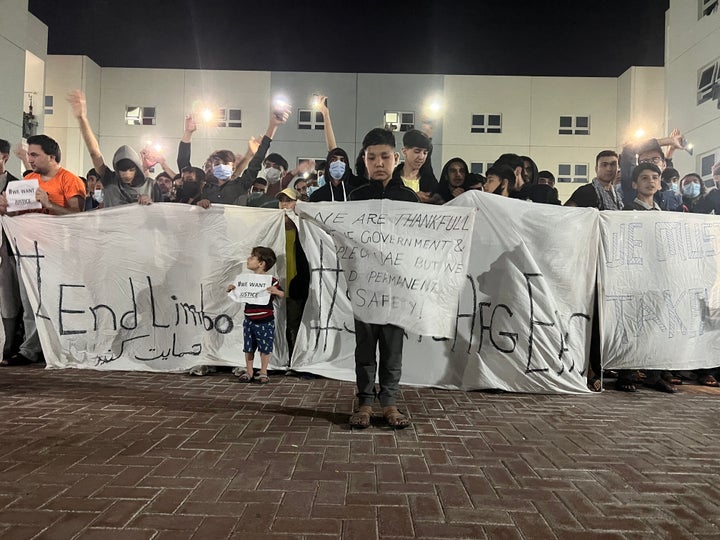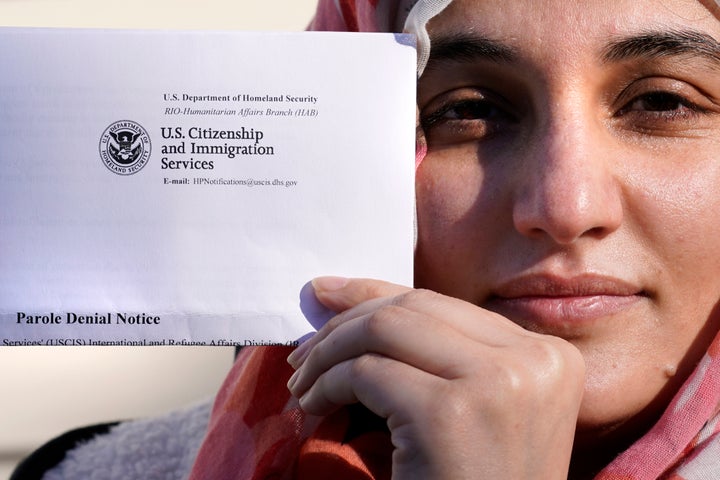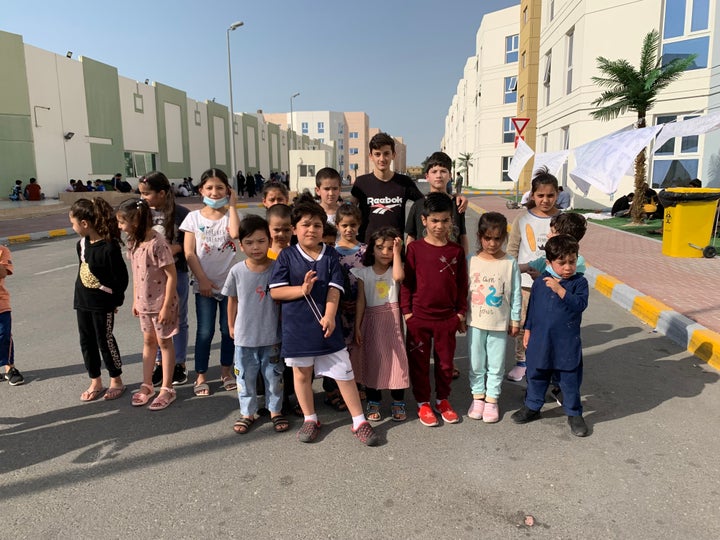Thousands of vulnerable Afghans who fled their homes have been stranded in Abu Dhabi facilities since last summer as they await travel to their final destination, including the U.S., in spite of assurances that they will get help soon.
The Emirates Humanitarian City in Abu Dhabi is currently housing approximately 9,000 Afghan evacuees. Among these Afghans are those who have worked with the U.S. and the Afghan Armed Forces, as well as other vulnerable Afghans such as journalists, judges, prosecutors, activists and ethnic and religious minorities who fled the country fearing that they would be targeted by the Taliban. Many of them have no clear path to resettlement in the U.S. or other countries.
Months of waiting, broken promises and a lack of clarity about next steps added to Afghans’ trauma of fleeing the Taliban.
Zahra Wahidi, who has lived in one of the two facilities in Abu Dhabi since October, told HuffPost she was promised to be there for no more than a few weeks.
“All I’ve heard since then are broken promises,” Wahidi said.
The frustration caused Afghans to protest inside the facility in February, demanding the U.S. government to resume flights and speed up processing.
“No one knows what’s next for them. People are confused and clueless,” protest organizer Ferdaws Ariayee said. “There is no way to return home and there is no way forward.”

Following the protest, a senior U.S. diplomat paid a visit to the base in March, apologizing to the thousands of Afghans stranded in the UAE and promising to expedite their resettlement to the U.S.
Flights to the U.S. were operating until November of last year, but then suddenly stopped initially due to a measles outbreak among Afghans and then because of other screening requirements. Despite assurances that the process would be resumed as soon as possible, flights effectively remained halted until April of this year.
Only four U.S. government charter flights have taken place since the resumption of the process in early April, According to Ariayee, who was on one of the flights and arrived in the U.S. in mid-May. Most eligible individuals for onward flights — particularly those with special immigrant visas, or SIVs, for people who worked with the U.S. — are expected to be relocated by August.
“We continue to work diligently to facilitate the relocation of all eligible individuals to the U.S. as they complete required medical examinations and other screening procedures required by public health directives and U.S. immigration law,” a State Department spokesperson told HuffPost.
The State Department was unable to provide more details about these flights, citing operational security, traveler safety and privacy concerns.
Those approved for SIVs also have another option, said Anna Lloyd, executive director of Task Force Argo, a group of private citizens working to evacuate Americans and Afghan partners. Those who have an approved SIV, once interviewed, can make independent departures with the help of the International Organization for Migration, a United Nations agency, by either paying for their tickets or receiving a loan from the agency. They can also receive complete assistance from the International Organization for Migration, but this is often a slower process so the agency can coordinate flights and resettlement assistance.

But not everyone with a clear path to resettlement in the U.S. has an approved SIV. A large number of SIV applicants are in the initial stages of the lengthy SIV application process, which could take months, or even years, to complete. This means that while these applicants will eventually arrive in the U.S., they will not be given priority for travel.
Wahidi worked for several years with a U.S.-funded project in Afghanistan before the Taliban took over and is eligible for an SIV. But she said there has been no update on her SIV status since she applied in September. The SIV pipeline currently has a backlog of tens of thousands of applications that have yet to be processed.
“There are too many people,” Wahidi said, “But the process is slow, and I believe I will be here for much longer than we were promised.”
In addition to SIVs, the State Department says that they are working to process those at the Emirates Humanitarian City who have confirmed cases for priority refugee admission, including those with referrals for the P1 and P2 refugee programs. Certain Afghans who have worked with the U.S. but are not eligible for SIV are eligible for the priority program.
Those may be the only options available to them, in spite of the U.S. government’s repeated assurances that it will not leave vulnerable Afghans behind after withdrawing troops from the country last year. No other visa categories or pathways for Afghans to get to the U.S. have been promised at this time.
No Path Forward
For now, chartered flights out of the Emirates Humanitarian City facilities are only available to those who were evacuated from Afghanistan directly by the U.S. Government as part of noncombatant evacuation operations in August. They do not include thousands of vulnerable Afghans who were relocated to the UAE by NGOs and volunteer groups, many of whom have no path to resettlement in the U.S., Lloyd said.
One of the NGOs helped Nesar Karimi relocate to Abu Dhabi last October; he had been threatened by the Taliban and forced to flee the country. He hopes to reunite with his two daughters living in the U.S. However, he is not eligible for an immigration visa that would allow him to immediately relocate. In order to bring him to the U.S., her daughters applied for humanitarian parole, which allows for temporary entry in the U.S., in December of last year. He has yet to receive a response to his application.
“Some people simply have to wait, but my fate is unknown,” Karimi said.
Since July 1, 45,000 people have applied for humanitarian parole, according to U.S. Citizenship and Immigration Services. Of those applicants, about 2,200 have been denied and approximately 270 have been conditionally approved.

Humanitarian parole cannot be processed in Abu Dhabi, Lloyd said. That visa category and anyone else with no valid pathway to the U.S. must find another country to receive them.
But according to Lloyd, no one is being forced to return to Afghanistan. Thus far, approximately 100 Afghans have repatriated to Afghanistan of their own free will. Most have returned to help family members in Afghanistan who are facing dire conditions, such as starvation.
“The U.S. government has largely abandoned leadership coordination with Afghan allies who served with the U.S. for two decades,” Lloyd said.
She said NGOs have been left to pick up the pieces to find Afghans safe haven in other countries while they await processing from the U.S.
“Our Afghan allies arrived in [the Emirates Humanitarian City] because there were no other options to stay alive and now are in a difficult position in the wake of the State Department’s absenteeism,” she said.
Temporary Housing Turns Long-Term
Emirates Humanitarian City comprises two facilities in an industrial neighborhood of Abu Dhabi. These facilities served as accommodation for the total population of approximately more than 10,000 Afghans over the past eight months. All Afghans have recently moved to one facility.
The royal family of the UAE funds support for Afghans in Emirates Humanitarian City. They provide housing, utilities, food, medical care, activities for children, a mosque and transportation to town for interviews at different embassies. They also brought in a Western Union service for money transfer and allow for mail and packages to be delivered, and even supervise family field trips out in town to boost morale.
“We owe the Royal Family of UAE a sincere amount of gratitude,” Lloyd said.
A State Department spokesperson told HuffPost the U.S. is working with the Emirati government, and thanks the UAE “for its partnership and ongoing support.”
While basic needs are met at the Emirates Humanitarian City, the prolonged confinement within tightly controlled facilities and uncertainty about next step has left some Afghans with serious physical and psychological issues.
“The condition is good here for those who fled a crisis and sought temporary shelter, but some people need better care, especially those with serious illness,” Karimi told HuffPost.
He has been suffering from kidney stones for years, and his problem has deteriorated since he was evacuated. He said that there is no proper treatment inside the Emirates Humanitarian City, and most illnesses are treated with painkillers with no diagnosis. He is scared that he might have long-term health issues if the problem is not treated.

Karimi is also concerned about the children in the facility. If they remain out of school for a long period of time, it might affect their normal learning process, he worries. Although there are schools for children that are set up recently, he said they are largely focused on teaching English.
Many Afghans have volunteered to teach at these schools. Wahidi teaches four days a week and is happy to distract herself with an activity that also helps others, particularly children. She went through months of serious depression and anxiety in the first few months of her arrival, but she had to find a way to deal with the situation.
“I enjoy teaching children, and this has also helped me to cope with the depression that I had because of the long wait and uncertainty,” Wahidi said.
She also spends her free time reading books, watching movies, and playing volleyball. Her goal is to continue her education once she resettles in the U.S. She spends some of her time every day looking for a scholarship and preparing her applications.
“What makes me accept this prison-like situation is hope for a better future in the U.S.,” Wahidi said.

